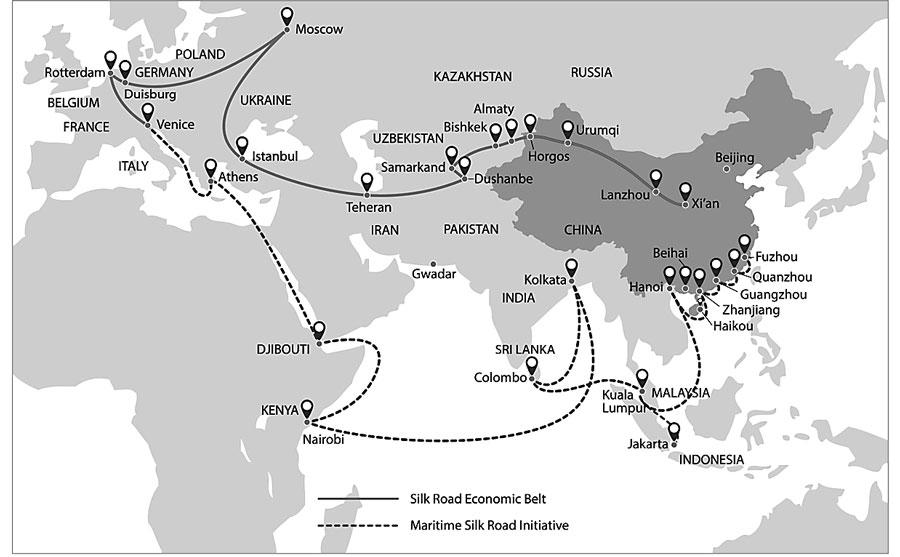Need for a new direction in foreign policy
Posted on June 6th, 2019
Dharshan Weerasekera

It is time for Sri Lanka to form a strategic alliance with China
What is at stake for SL is nothing less than complete subjugation to the Americans and the resulting loss of the sovereignty

For nearly 70 years since independence, the principles of ‘neutralism’ and ‘non-alignment’ have guided Sri Lankan foreign policy. However, four geopolitical changes, to wit: many ‘non-aligned’ countries are now close allies and ‘partners’ of the US; the ‘Pivot to Asia’ by the Americans; China’s Belt and Road initiative; the new threat of Islamic terrorism in this country and the danger that interested parties might try to set up a permanent military presence here under the pretext of helping Sri Lankans ‘fight terror’ raise questions about the continuing utility of those principles for this country.
I argue that it is time for Sri Lanka to form a strategic alliance with China. As long as the ‘Pivot to Asia’ is a major part of the US policy, and there is no indication this will change in the foreseeable future, the US will try to gain maximum indirect control over Sri Lanka owing to the importance of this country to the overall purposes of the pivot. The only question is whether Sri Lankans choose to face this onslaught alone or ally themselves with a powerful nation in order to balance the scales of power.
An obvious choice for such an alliance is India. However, India is now working hand in glove with the US. That leaves China as the only viable candidate for an alliance. I shall briefly discuss: 1) The ‘Pivot to Asia’ and its impact on Sri Lanka; 2) China’s Belt and Road initiative and the economic opportunities it opens for Sri Lanka; and 3) The proposed foreign policy and its advantages, and meet objections.
‘Pivot to Asia’ and its impact on Sri Lanka
‘Pivot to Asia’ is a formal decision by the Obama administration in 2011 that the future prosperity of the US depends on developments in the Indo-Pacific region, and to devote American resources into gaining control over that territory. The pivot continues to be a major part of US policy under the Trump administration.
The pivot puts the Americans on a collision course with China. As well-known Australian journalist John Pilger says:
The United States is encircling China with a network of bases, with ballistic missiles, battle groups and nuclear-armed bombers. This lethal arc extends from Australia to the islands in the Pacific, the Marianas and the Marshals and Guam, to the Philippines, Thailand, Okinawa, Korea and across Eurasia to Afghanistan and India. America has hung a noose around the neck of China.”
Sri Lanka’s location in the middle of the Indian Ocean makes it a vital asset to both the Americans as well as the Chinese: the former to help complete the aforementioned encirclement and the latter to break out of it and in general frustrate the US’ designs in this region.
To advance the goals of the pivot, the Americans have modified the ‘rules-based order’ which relied on the US’ traditional allies in the region by adding ‘partners.Admiral Harry B. Harris, former head of the US Pacific Command, has described the new system in a speech to the Senate Armed Forces Committee in 2017 as follows:
This security order has been reinforced by America’s five bilateral security alliances with Australia, Japan, the Republic of Korea(RoK), the Philippines and Thailand. This order is further bolstered by our growing partnerships with India, Indonesia, Malaysia, New Zealand, Singapore, Sri Lanka, Mongolia and Vietnam.”
It is in this context that one must consider the things that the Americans have been doing in Sri Lanka over the past 3-4 years. The US has pursued four tactics:
a) Action at the UNHRC to compel Sri Lanka to undertake internal reforms
b) Constitutional reforms: To bring about a solution to the ‘ethnic problem.’USAID organised seminars and workshops to promote the new Constitution. If the new Constitution had been enacted, it would have turned Sri Lanka into an ‘orumittha nadu’ (i.e. a confederation of the 9 provinces which by definition would have given each of them a unilateral right to secession).
c) Economic reforms: These include a complete overhaul of monetary laws including the tax law
d) Military reforms: These include the creation of a battalion of Marines capable of being deployed with the US Marines and the proposed new Status of Forces Agreement.
Economic Opportunities
The Belt and Road initiative launched in 2013 will connect China with the Middle East and Europe by a system of roads, railroads and sea ports. In recent years, China has extended the BRI to Africa. Sri Lanka is undoubtedly primed to play a key role in the sea route. The opportunities that the Belt and Road opens for Sri Lanka go far beyond providing docking facilities for the ships plying the route. Ultimately, the Belt and Road could stimulate domestic technologies and industries – something that has not happened on a large-scale under the system that has prevailed since independence.
After nearly 70 years of economic dependence on the West including foreign aid, all that Sri Lanka has to show for it is to have the West make a mockery of this country’s sovereignty, as for instance when the EU demanded that Sri Lanka fulfilled 58 conditions — those that had nothing to do with economics but rather with amending criminal statutes — if the GSP-Plus facility were to be reinstated.
Meanwhile, Sri Lanka is reduced to competing with Afghanistan for the dubious honour of having the worst economy in South Asia. Reason and common sense suggest that if there is a way out of this situation Sri Lankans ought to take it, and the Belt and Road at least on the face of it appears to offer such a way out.
Proposed Foreign Policy
If the ultimate goal of US strategy in Asia is to defeat China and Sri Lanka is a ‘partner’ in the US’ strategic network, this country – whether it likes it or not – will have to support the efforts designed to harm Chinese interests. So, either Sri Lankans must publicly accept the premises of the Americans in respect of China or reject them.
If they choose the Americans, it might stop the Americans from undermining the sovereignty of the country as they have been doing in the last 4 years. On the other hand, if they choose the Chinese, the Chinese will be free to expand their investments in Sri Lanka and commit fully to helping develop this country.
An alliance with China will also: a) Permit Sri Lankans to call on Russia in combatting the machinations of the Americans and their allies; and b) Provide economic security in the event the US and its allies wage ‘economic war’ against Sri Lanka. So, Sri Lankans should adopt a new foreign policy based on the following three ideas:
a) A commitment that Sri Lanka shall not support activities that directly or indirectly harm or have the potential to harm the interests of China. However, this will be balanced by a commitment that, in the event of a war between China and another country, the territory including territorial waters of Sri Lanka shall not be available to either of those parties to engage in any activity related to the prosecution of such war.
b) An economic policy focused on the Belt and Road
c) A strong dependence on international law and actions at the International Court of Justice (ICJ) — rather than the US’ ‘Rules-based Order’ and related bilateral treaties — to protect Sri Lanka’s sovereignty and territorial integrity in the event of undue interference by international actors.
To turn to objections, the main objection that a critic might make is that an attempt by Sri Lanka to form an alliance with China will bring down the full wrath of the Americans and their allies on the heads of the Sri Lankans. I concede that the danger is very real. However, what is at stake for Sri Lanka is nothing less than complete subjugation to the Americans and the resulting loss of the sovereignty and independence of this country forever. Under the circumstances, the reward is worth the risk.
Furthermore, the following two factors might also help mitigate the risk involved: First, the qualification that Sri Lanka will be neutral in the event of a war. This can address one of the chief security concerns of the Americans, namely, that in the event of a war the Chinese will use Sri Lankato gain a military advantage in the Indian Ocean. Second, the emphasis on the Belt and Road rather than on Beijing per se. The alliance with China is primarily a commercial alliance. The Americans and their allies can do as much business as they want in Sri Lanka. This will be particularly attractive to American companies, since, as is well-known, the ‘Business of America is business.’ These companies can lobby the US Government to leave Sri Lanka to its own devises.
June 6th, 2019 at 10:11 pm
Change America or USA to India or Baratha and you will see the real picture.
But then most of us the Sinhalese are blinded by years and years of brainwashing by the Indian Parasite Socialists and their followers.
The writer carries on about John Pilger a man who lives off Indians and who have always taken the side of Indian terrorists the LTTE branded Tamil Tigers. If I am not mistaken this guy has always refereed to Sinhalese as chauvinists.
We have been an independent nation; forget Indians lead Non-Aliened garbage.
We shipped rubber to China during the height of the Korean war and we did not have any trouble.